Aylesbury Vale Area Design Supplementary Planning Document
1. Purpose of the Design SPD
1.1 Overall objectives
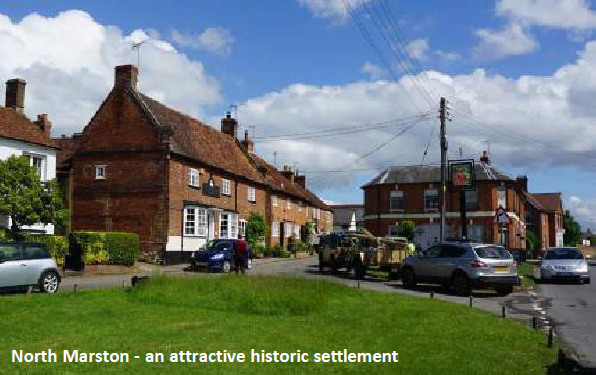
1.1.4 VALP promotes growth that is shaped by strong place-shaping and sustainability principles to create well-designed developments that are sensitive to the area's local character and heritage and well integrated with existing communities, both in terms of scale, land- use and design.
1.1.5 The council is committed to achieving high design quality and local distinctiveness in new development and in creating desirable places and exemplar buildings, that will be appreciated by future generations.
1.1.6 This Supplementary Planning Document (SPD) is intended to inform and guide the quality of design for all development across the area. Whilst an important focus is large urban extensions, it is equally important in guiding the design of proposals for a single house, for a household extension or building conversion.
1.1.7 The Design SPD puts forward principles and standards for new development that aim to create safe and attractive places that are sensitive to, and maintain or enhance, Aylesbury Vale's special character, while also allowing creative and innovative design solutions.
VALP POLICY BE2: Design of new development
All new development proposals shall respect andcomplement the following criteria:
- The physical characteristics of the site and its surroundings including the scale and context of the site and its setting;
- The local distinctiveness and vernacular character of the locality, in terms of ordering, form, proportions, architectural detailing and materials;
- The natural qualities and features of the area; and
- The effect on important public views and skylines.
More guidance on the detail for the application and implementation of this policy will be provided in the District Design SPD.
1.1.8 High quality design is essential to optimise the development potential of sites and also to deliver the kind of places that will provide economic and environmental well-being and quality of life for the area's residents, both now and into the future.
1.1.9 This Design SPD provides a design-led approach to development. This follows the direction set out in the NPPF, the National Design Guide and VALP Policy BE2 – Design of new development.
1.2 How to use the Design SPD
1.2.1 This Design SPD is intended for frequent reference and will be essential for anyone charged with preparing or assessing the quality of planning applications including:
- Developers and builders, in considering potential development proposals;
- Householders, considering residential extensions;
- Design professionals, in drawing up schemes for development;
- Plan making town and parish councils, statutory and non-statutory consultees and the public in commenting on planning applications; and
- The council, in determining planning applications and in informing decisions at planning appeals.
1.2.2 The Design SPD consists of design principles (highlighted throughout the document) that development should adhere to. This is accompanied by descriptive text, illustrations and photographs of best practice examples including case studies from both within the area and elsewhere. Poor practice is also illustrated. Where appropriate reference to VALP policy is made.
1.2.3 The SPD is laid out in a consistent manner in each section for ease of use
Structure of the SPD
1.2.4 The Design SPD is structured in nine chapters. The early chapters are set out in the sequence in which designers are expected to prepare their proposals. Refer also to the flowchart (Figure 2.1) in Section 2.1 - the design process. Later chapters focus on development in the countryside (Chapter 7) and on household extensions (Chapter 8) and building conversions (Chapter 9).
1.2.5 Each chapter is structured around a number of design principles that are required to be followed when designing and promoting new development within Aylesbury Vale. The principles are drawn from best practice (see additional resources below), respond to the unique environment within the area and are intended to guide and assist applicants on the design aspects that must be considered and addressed when drawing up their proposals.
1.2.6 This Design SPD provides general guidance on the form that new development should take. This addresses a range of development types including:
- New urban extensions and large residential developments;
- Brownfield and urban infill sites;
- Employment and commercial sites;
- New dwelling design;
- Household extensions; and
- Building conversions.
1.2.7 Not all principles will be relevant for smaller scale development proposals (including for single dwellings, household extensions or building conversions). Some elements, are most relevant for larger sites which must establish their own structure, either as part of an existing settlement or as an extension to an existing settlement.
1.2.8 Figure 1.2, lists the design principles and identifies the development types to which each is relevant. This is presented in the form of a table over five pages. The table also indicates the relationship between the design principles and the ten National Design Guide characteristics (refer to Appendix A - National Design Guide).
Checklists
1.2.9 Checklists are provided at the end of each chapter. The checklists are intended to act as prompts to applicants to ensure that the issues raised are considered at the right stage of the design process and to optimise the potential of the site to accommodate appropriate development.
1.2.10 Not all checklists or all the issues raised in individual checklists will apply to every site and each case will be decided on its merits.
1.2.11 Applicants are expected to demonstrate compliance where checklists do apply or robustly justify their proposals where a different approach has been taken.
Additional resources:
- National Design Guide Go to Government website
- National Model Design Code Go to Government website
- Building for a Healthy Life design toolkit Go to Building for Life website
- Living with Beauty Go to Government website
- Urban Design Compendium 2 Go to Academia website
Please use the scroll bars at the bottom of the tables below to see all the data:
|
Design SPD Chapter |
Page | Design Principles | National Design Guide Characteristics |
DEVELOPMENT TYPES |
|||||||||
|
Strategic housing developments / urban extensions(300+ homes) |
Major residential development (10- 300 dwellings) |
Smaller residential proposals (2-9 homes) |
Brownfield and urban infill |
Commercial or employment |
Mixed use scheme |
Individual houses within settlements |
Individual houses in rural settings |
Household extensions |
Building conversions |
||||
|
3. Understanding the context |
28 |
DES1: Designations |
1 |
Yes | Yes | Yes | Yes | Yes | Yes | Yes | Yes | Yes | Yes |
|
36 |
DES2: Landscape character |
1 |
Yes | Yes | Yes | Yes | No | Yes | No | Yes | No | No | |
|
39 |
DES3: Ecology |
1, 2, 5 |
Yes | Yes | Yes | Yes | Yes | Yes | Yes | Yes | Yes | Yes | |
|
42 |
DES4: Settlement and site context |
1 |
Yes | Yes | Yes | Yes | Yes | Yes | Yes | Yes | Yes | Yes | |
|
47 |
DES5: Aylesbury Garden Town |
1 |
Yes | Yes | Yes | Yes | Yes | Yes | Yes | Yes | Yes | Yes | |
|
48 |
DES6: Responding to local vernacular and distinctiveness |
1, 2 |
Yes | Yes | Yes | Yes | Yes | Yes | Yes | Yes | Yes | Yes | |
|
52 |
DES7: CharacterStudy |
1, 2 |
Yes | Yes | Yes | Yes | Yes | Yes | Yes | Yes | Yes | Yes | |
|
53 |
DES8: Site Appraisal |
1 |
Yes | Yes | Yes | Yes | Yes | Yes | Yes | Yes | Yes | Yes | |
|
4. Establishing thestructure |
60 |
DES9: Work with the natural features and resources of the site |
1, 2, 5, 9 |
Yes | Yes | Yes | Yes | Yes | Yes | Yes | Yes | No | No |
|
62 |
DES10: Respond to topography and strategic views |
1, 2, 5, 9 |
Yes | Yes | Yes | Yes | Yes | Yes | No | No | No | No | |
|
63 |
DES11: Establish a landscape and green infrastructure network |
2, 5, 9, 10 |
Yes | Yes | Yes | Yes | Yes | Yes | No | No | No | No | |
|
65 |
DES12: Water features and sustainable drainage systems |
2, 5, 9, 10 |
Yes | Yes | Yes | Yes | Yes | Yes | No | No | No | No | |
|
67 |
DES13: Design to enhance biodiversity |
5, 9, 10 |
Yes | Yes | Yes | Yes | Yes | Yes | Yes | Yes | Yes | Yes | |
|
69 |
DES14: Establish a clear movement network that connects with the surrounding area |
1, 4, 10 |
Yes | Yes | Yes | Yes | Yes | Yes | No | No | No | No | |
|
70 |
DES15: Reduce reliance on the private car |
4, 9, 10 |
Yes | Yes | Yes | Yes | Yes | Yes | No | No | No | No | |
|
71 |
DES16: Anticipate future development |
4, 10 |
Yes | Yes | Yes | Yes | Yes | Yes | No | No | No | No | |
|
72 |
DES17: Respond to the existing townscape, heritage assets, historic landscapes / archaeology |
2, 9, 10 |
Yes | Yes | Yes | Yes | Yes | Yes | Yes | No | No | No | |
Figure 1.2: Table setting out the structure of the Design SPD, the design principles and the type of developments to which they are applicable and relationship with National Design Guide (part 1)
|
Design SPD Chapter |
Page | Design Principles | National Design Guide Characteristics |
DEVELOPMENT TYPES |
|||||||||
|
Strategic housing developments / urban extensions(300+ homes) |
Major residential development (10- 300 dwellings) |
Smaller residential proposals (2-9 homes) |
Brownfield and urban infill |
Commercial or employment |
Mixed use scheme |
Individual houses within settlements |
Individual houses in rural settings |
Household extensions |
Building conversions |
||||
|
5. Site layout, streets and spaces |
80 |
DES18: Design for every one and look to the future |
9, 10 |
Yes | Yes | Yes | Yes | Yes | Yes | Yes | Yes | Yes | Yes |
|
81 |
DES19: Deliver a clear structure of streets and spaces that is easy to understand and move through |
4, 6 |
Yes | Yes | Yes | Yes | No | Yes | No | No | No | No | |
|
83 |
DES20: Provide enclosure and positive frontage to streets |
3, 4 |
Yes | Yes | Yes | Yes | No | Yes | Yes | Yes | No | No | |
|
85 |
DES21: Promote a mix of uses within larger schemes to provide services to meet local needs, conveniently located where they are most accessible |
7 |
Yes | No | No | No | No | Yes | No | No | No | No | |
|
85 |
DES22: Provide a mix of residential typologies within residential schemes to create mixed communities and ensure these are adaptable to change |
7, 8, 10 |
Yes | Yes | Yes | Yes | No | Yes | No | No | No | No | |
|
88 |
DES23: Ensure that development density and the scale and massing of proposed buildings responds to the existing and emerging character and context of an area |
1, 2, 3 |
Yes | Yes | Yes | Yes | No | Yes | No | No | No | No | |
|
90 |
DES24: Usemarkers, landmarks, vistas and street hierarchy to aid legibility |
2 |
Yes | Yes | Yes | Yes | No | Yes | No | No | No | No | |
|
91 |
DES25: Create a positive development edge |
3, 5 |
Yes | Yes | No | No | No | No | No | No | No | No | |
|
92 |
DES26: Provide attractive streets and spaces defined by buildings rather than the highway, that encourage low speeds and that are safe to use by everyone |
3, 4, 9, 10 |
Yes | Yes | Yes | Yes | No | Yes | No | No | No | No | |
|
94 |
DES27: Integrate parking to meet needs and support attractive streets and spaces |
4, 6, 8 |
Yes | Yes | Yes | Yes | Yes | Yes | Yes | Yes | No | No | |
|
98 |
DES28: Plan for cyclists |
4, 9, 10 |
Yes | Yes | Yes | Yes | No | Yes | No | No | No | No | |
|
100 |
DES29: Deliver attractive and efficient employment are as and infrastructure |
7, 9 |
Yes | Yes | Yes | Yes | Yes | Yes | No | No | No | No | |
|
102 |
DES30: Consider and allow for servicing, refuse collection and deliveries |
8, 9 |
Yes | Yes | Yes | Yes | Yes | Yes | Yes | Yes | No | No | |
|
103 |
DES31: Integrate refuse and recycling into the design of new development |
8, 9 |
Yes | Yes | Yes | Yes | Yes | Yes | Yes | Yes | No | No | |
|
103 |
DES32: Plan for and integrate sub-stations, utilities and pump stations into the design of new development |
3, 8, 9 |
Yes | Yes | Yes | Yes | No | Yes | No | No | No | No | |
|
Design SPD Chapter |
Page | Design Principles | National Design Guide Characteristics |
DEVELOPMENT TYPES |
|||||||||
|
Strategic housing developments / urban extensions(300+ homes) |
Major residential development (10- 300 dwellings) |
Smaller residential proposals (2-9 homes) |
Brownfield and urban infill |
Commercial or employment |
Mixed use scheme |
Individual houses within settlements |
Individual houses in rural settings |
Household extensions |
Building conversions |
||||
|
5. Site layout, streets and spaces |
104 |
DES33: Enhance the environment and sense of place through open spaces |
5, 6 |
Yes | Yes | Yes | Yes | No | Yes | No | No | No | No |
|
106 |
DES34: Integrate space for play into the design |
6 |
Yes | Yes | Yes | Yes | No | Yes | No | No | No | No | |
|
107 |
DES35: Enhance the environment and sense of place through tree planting and soft landscape |
5, 6, 9 |
Yes | Yes | Yes | Yes | No | Yes | No | No | No | No | |
|
110 |
DES36: Deliver a high quality, coordinated and attractive public realm that is easy to manage and maintain |
6, 9, 10 |
Yes | Yes | Yes | Yes | No | Yes | No | No | No | No | |
|
6. High quality andsustainable buildingdesign |
118 |
DES37: Promote high quality buildings that respond to their location and deliver a sense of place |
2, 3, 8 |
Yes | Yes | Yes | Yes | No | Yes | Yes | Yes | No | No |
|
124 |
DES38: Promote buildings that respond to and help to animate the street space |
3, 6 |
Yes | Yes | Yes | Yes | No | Yes | Yes | Yes | No | No | |
|
128 |
DES39: Promote buildings that have architectural integrity utilising high quality materials and detailing |
8, 9, 10 |
Yes | Yes | Yes | Yes | No | Yes | Yes | Yes | No | No | |
|
135 |
DES40: Consider the location and design of utility meters and external pipes so that they don't adversely impact the quality of development |
8, 9, 10 |
Yes | Yes | Yes | Yes | No | Yes | Yes | Yes | No | No | |
|
136 |
DES41: New development must be designed to respect the privacy of existing residents |
8, 9 |
Yes | Yes | Yes | Yes | No | Yes | Yes | Yes | No | No | |
|
137 |
DES42: Provide attractive and usable external amenity space for all homes |
6 |
Yes | Yes | Yes | Yes | No | Yes | Yes | Yes | No | No | |
|
138 |
DES43: Homes should be designed to receive adequate daylight and sunlight and to avoid overshadowing |
8, 9 |
Yes | Yes | Yes | Yes | No | Yes | Yes | Yes | No | No | |
|
138 |
DES44: Design to minimise the impactsof noise,air and light pollution |
8, 9 |
Yes | Yes | Yes | Yes | No | Yes | Yes | Yes | No | No | |
|
139 |
DES45: Commercial buildings |
8, 9 |
No | No | No | No | Yes | No | No | No | No | No | |
|
140 |
DES46: Minimise environmental impact by energy efficient and sustainable design |
9, 10 |
Yes | Yes | Yes | Yes | Yes | Yes | Yes | Yes | Yes | Yes | |
|
141 |
DES47: Living roofs and walls |
9, 10 |
Yes | Yes | Yes | Yes | Yes | Yes | Yes | Yes | Yes | Yes | |
|
Design SPD Chapter |
Page | Design Principles | National Design Guide Characteristics |
DEVELOPMENT TYPES |
|||||||||
|
Strategic housing developments / urban extensions(300+ homes) |
Major residential development (10- 300 dwellings) |
Smaller residential proposals (2-9 homes) |
Brownfield and urban infill |
Commercial or employment |
Mixed use scheme |
Individual houses within settlements |
Individual houses in rural settings |
Household extensions |
Building conversions |
||||
|
6. High quality and sustainable building design |
144 |
DES48: Sustainable building materials |
9, 10 |
Yes | Yes | Yes | Yes | Yes | Yes | Yes | Yes | Yes | Yes |
|
145 |
DES49: Local energy production |
9, 10 |
Yes | Yes | Yes | Yes | Yes | Yes | Yes | Yes | Yes | Yes | |
|
146 |
DES50: Reducing water demand |
9, 10 |
Yes | Yes | Yes | Yes | Yes | Yes | Yes | Yes | Yes | Yes | |
|
7. Development in the countryside |
152 |
DES51: Respond to the landscape setting |
1, 2 |
No | No | No | No | No | No | No | Yes | No | No |
|
156 |
DES52: Residential buildings |
8 |
No | No | No | No | No | No | No | Yes | No | No | |
|
158 |
DES53: Rural boundary treatments |
1, 2 |
No | No | No | No | No | No | No | Yes | No | No | |
|
159 |
DES54: Agricultural and equestrian buildings |
1, 2 |
No | No | No | No | Yes | No | No | No | No | No | |
Figure 1.2: Table setting out the structure of the Design SPD, the design principles and the type of developments to which they are applicable and relationship with National Design Guide (part 4)
|
Design SPD Chapter |
Page | Design Principles | National Design Guide Characteristics |
DEVELOPMENT TYPES |
|||||||||
|
Strategic housing developments / urban extensions(300+ homes) |
Major residential development (10- 300 dwellings) |
Smaller residential proposals (2-9 homes) |
Brownfield and urban infill |
Commercial or employment |
Mixed use scheme |
Individual houses within settlements |
Individual houses in rural settings |
Household extensions |
Building conversions |
||||
|
8. Household extensions |
165 |
DES55: Responding to local character |
1, 2 |
No | No | No | No | No | No | No | No | Yes | No |
|
165 |
DES56: Consider your neighbours |
8 |
No | No | No | No | No | No | No | No | Yes | No | |
|
166 |
DES57: Scale and massing |
2, 8 |
No | No | No | No | No | No | No | No | Yes | No | |
|
168 |
DES58: Respond to the design of the original dwelling |
2, 8 |
No | No | No | No | No | No | No | No | Yes | No | |
|
170 |
DES59: Side extensions |
2, 8 |
No | No | No | No | No | No | No | No | Yes | No | |
|
171 |
DES60: Front extensions, canopies and porches |
2, 8 |
No | No | No | No | No | No | No | No | Yes | No | |
|
172 |
DES61: Rear extensions |
2, 8 |
No | No | No | No | No | No | No | No | Yes | No | |
|
173 |
DES62: Loft conversions and roof extensions |
2, 8 |
No | No | No | No | No | No | No | No | Yes | No | |
|
174 |
DES63: Car parking and garages |
2, 8 |
No | No | No | No | No | No | No | No | Yes | No | |
|
9. Building conversions |
178 |
DES64: Conversion of traditional agricultural buildings |
2, 9, 10 |
No | No | No | No | No | No | No | No | No | Yes |
|
183 |
DES65: The curtilage of agricultural conversions should respond to its rural context |
2, 9, 10 |
No | No | No | No | No | No | No | No | No | Yes | |
|
185 |
DES66: Conversion of chapels, schools and churches |
2, 9, 10 |
No | No | No | No | No | No | No | No | No | Yes | |
|
187 |
DES67: Conversion of commercial buildings |
2, 9, 10 |
No | No | No | No | No | No | No | No | No | Yes | |
Figure 1.2: Table setting out the structure of the Design SPD, the design principles and the type of developments to which they are applicable and relationship with National Design Guide (part 5)
1.3 Opportunities and constraints
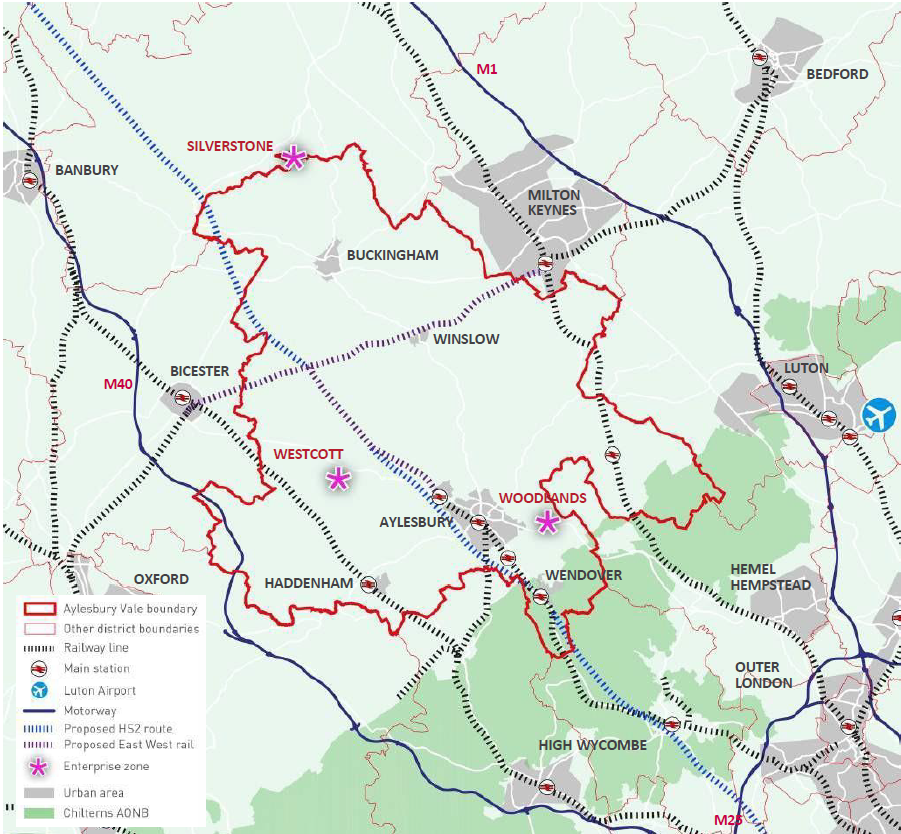
Figure 1.3: Aylesbury Vale Context Plan
1.3.1 Aylesbury Vale is a rural area set in beautiful countryside and benefiting from good access to London. The south-eastern part of the area is set within the Chilterns Area of Outstanding Natural Beauty (AONB) and almost a third is locally designated landscape.
1.3.2 The area is located between the M40 and M1 motorways and with Oxford, Banbury and Bicester to the west and Milton Keynes to the east but despite its proximity to London many parts of the area are sparsely populated and experience 'dark skies' at night.
1.3.3 Aylesbury is by far the largest settlement within the area, with over 40% of the population living there. It is also the county town of Buckinghamshire. Aylesbury was awarded Garden Town status by the Government in January 2017. The area has over 80 other settlements of varying sizes with Buckingham, Haddenham, Wendover and Winslow the largest and each providing local facilities that serve the surrounding rural areas. Many of the settlements in the area are attractive and historic.
1.3.4 Aylesbury Vale is experiencing pressure for growth with the VALP setting a housing provision of over 30,000 homes in the period up to 2033 to meet the needs of Aylesbury Vale as well as unmet needs from Wycombe, Chiltern and South Bucks districts. This housing growth is concentrated in sustainable locations with the majority of homes focused in Aylesbury Garden Town, to the north in the vicinity of Milton Keynes and a smaller proportion in Buckingham, Winslow, Wendover and Haddenham (strategic settlements).

1.3.5 This is supported by growth at other larger and medium sized villages and with Neighbourhood Plans identifying housing growth in smaller settlements.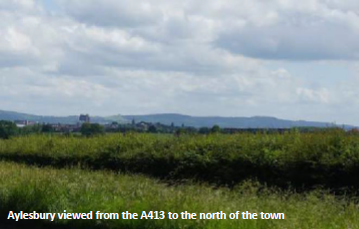
1.3.6 Significant employment growth is also planned with over 100 hectares of employment land identified predominantly around Aylesbury but also close to Milton Keynes in north east Aylesbury Vale. The area benefits from three sites with Enterprise Zone status at Silverstone Park, Westcott and Woodlands each focusing on different high growth sectors.
1.3.7 These new homes and jobs provide opportunities for the area, helping to sustain its towns and villages and improve their economic performance, but also present challenges.
1.3.8 The area contains many environmental designations which influence where development may take place and it is important that change does not erode the essentially rural character of the area, its rich heritage and the historic and distinctive character of its towns and rural settlements.
1.3.9 There are also a number of strategic infrastructure proposals that could both impact on the character of parts of the area but also improve accessibility. These are:
- High Speed 2 (HS2) which will, extend north-south through the area and provide a rapid rail connection from London to Birmingham; and
- East West Rail (EWR) which seeks to re-establish the former Varsity line east-west across the area and will include a new station at Winslow and a spur route connecting to Aylesbury. Phase 1 is open from Oxford to Bicester with the second section to Bedford planned for completion in 2024 and options for a further extension to Cambridge and beyond coming forward.
1.4 The value of good design
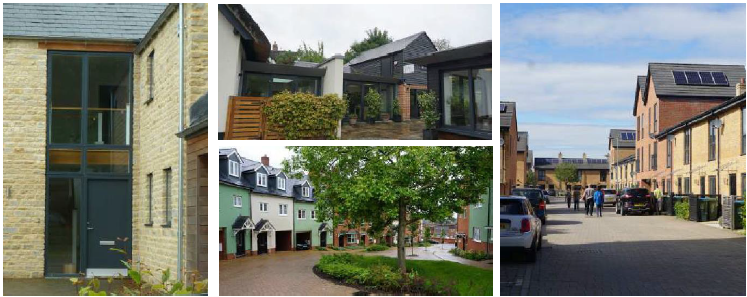
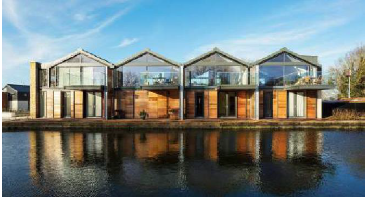
Examples of more innovative design delivered in the Aylesbury Vale in recent years, FROM LEFT: Gorrell Lane, Dadford (facade detailing / use of materials); Chandos Yard, Long Crendon (response to context); housing at Summer Hill, Buckingham (landscape and public realm); Drakes Place, Aylesbury (contemporary housing); and Marmsworth Yard (response to wharfside character).
1.4.1 The importance of design quality is intrinsic to national planning policy with a clear mandate within the National Planning Policy Framework (NPPF) to deliver high quality built environments.
1.4.2 Good design can help transform places and enhance people's lives. The orientation and height of buildings; the materiality, enclosure and sunlight within a public space and the presence or absence of trees and planting in a street or space can have a profound impact on people's wellbeing and mental health. Good design and introduction of green infrastructure in particular can also improve the environment, reducing the carbon footprint, air pollution and overheating in summer, and improving water quality and management.
1.4.3 Research by the Commission for Architecture and the Built Environment (CABE) and the Royal Institute of British Architects (RIBA) and national guidance, including the Urban Design Compendium, have all demonstrated the link between good design and improved quality of life, equality of opportunity and economic growth.
1.4.4 As an example:
- A well designed hospital will help patients get better more quickly;
- A well designed school will improve the educational achievement of its pupils;
- A well designed park will improve health and well being;
- A well designed public realm increases retail rents;
- A well designed department store will have a direct impact on stock turnover; and
- A well designed neighbourhood will benefit from lower crime and increased value.
1.4.5 Good design is about more than just the architecture and in Aylesbury Vale we are looking to create high quality places that meet the needs of the whole community with streets and spaces that are accessible for everyone, that function well and improve the quality of life.
1.4.6 Good design from the outset, in accordance with the principles contained within this Design SPD, is likely to smooth the planning process. Pre-application discussions and Planning Performance Agreements can also assist this process.
1.4.7 The council celebrates projects which make an outstanding contribution to the design quality of the built environment in the area through annual design awards. These awards have been running for over 25 years and showcase good design of both small and larger developments including new build, building conversion and building refurbishment.
1.5 High quality design and innovation
1.5.1 The aim of this SPD is to inspire designers to rise to the challenge of delivering high quality, well designed buildings, streets and spaces that are in keeping with their environment and respond to the challenge of delivering sustainable development.
1.5.2 Designers are encouraged to be inventive and innovative; to prepare proposals that respond to place, that meet the needs of modern lifestyles and that are adaptable in the future. Contemporary solutions of high architectural quality that deliver outstanding places are welcomed and encouraged where they respond to and maintain or enhance their context.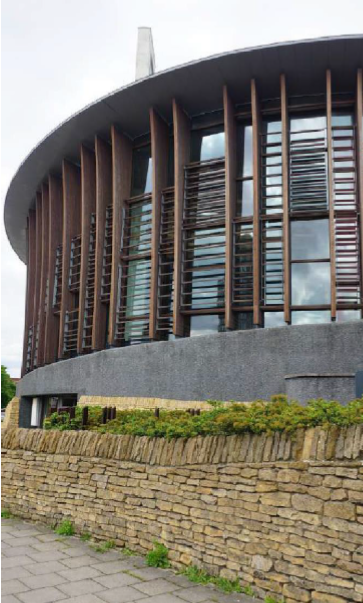
1.5.3 This Design SPD is intended to be a design manual and a working tool. It is intended for frequent reference and will be essential for anyone charged with preparing or assessing the quality of planning applications.
1.5.4 Compliance with the Design SPD will help to speed up the planning process by reducing the chance of objections due to poor design.
1.5.5 This draft document is subject to a formal 6 week period of public consultation between XXXX to XXXX with statutory consultees, developers and the local community. Following consultation there will be a review of the feedback received and where appropriate changes will be made to the Design SPD.
1.5.6 The Design SPD will be adopted by the council and as such will be a material consideration in determining planning applications submitted to the council. Having been subject to scrutiny and amendment through a public consultation process, the SPD will carry weight in decision making.
Additional useful and interesting resources:
- Paved with gold: The real value of good street design (CABE, 2007)
- By Design, Urban design in the planning system: Towards better practice (DETR and CABE, 2000)
- The value of good design (CABE, 2002)
- The value of urban design (CABE and DETR, 2001)
- Valuing Sustainable Urbanism (Prince’s Foundation, Savills and English Partnerships, 2007)
- Public Health England briefing for local authorities - Working together to promote active travel (2016)
- Building the foundations - tackling obesity through planning and development (LGA, 2016)





